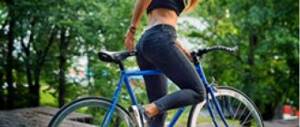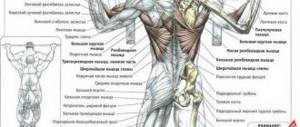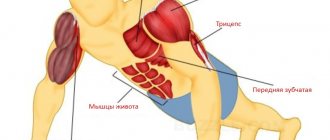A bicycle today is no longer considered a means of transportation, but a way to have a good time, play sports, be in the fresh air, combining business with pleasure. This sports equipment can become our reliable assistant in the matter of losing weight and pumping up muscles. Avid cyclists probably know which muscles work when riding a bicycle. It is this question that needs to be considered in more detail.
Cycling: what muscles work?
Let's look at what muscle groups work on a bicycle. The list of them is actually quite impressive.
Leg muscles
- Calf muscles. They are worked out when you extend your foot while pressing the pedal. The hamstrings are also included in the work.
- Quadriceps . They get quite a heavy load. Their task is to ensure strong pedal pressure. The maximum tension of these muscles is felt when you ride your bike up a hill, applying maximum effort.
- Hip flexor. A small iliacus muscle located in the groin area that helps both extend the hip and bend the leg at the knee. This muscle is quite vulnerable, especially in relation to cycling. Therefore, you need to focus on your feelings and avoid discomfort in it.
Buttocks
The gluteal muscles sway when cycling, working in tandem with the quadriceps. They also help keep the body in the correct position when riding.
Hips
The biceps of the thigh works when lifting the leg up with a pedal.
Press
Of course, cycling trains your abdominal and back muscles. They allow you to maintain a straight back and correct body position in general. They are also involved when bending forward, so it is important that the abdominal muscles are strong enough.
Is it possible to pump up your abs during your period?
Arms and shoulders
Since cycling trains the muscles of the upper body much less than the lower body, many professional cyclists have strong toned legs and buttocks and not very trained arms and shoulders.
Basically, the muscles of the arms and shoulders are needed when turning the steering wheel and holding it during steep descents. And, of course, you can’t do without them if you need to periodically bring your bike in and out of the room and back. Typically, the triceps work as hard as possible, extending the arms at the elbows to coordinate the distance of the torso from the handlebars of the bicycle.
The shoulder girdle is loaded when standing on the pedals , when all the muscles of the body are involved. If you are riding up a steep hill, then on the contrary you will have to lower the bike, push it away from you, and press it to the surface. On a flat surface, your arms and shoulders do little work, but on hilly and mountainous surfaces they have to work hard, so if you want to work them too, choose these types of landscapes.
Many people are also interested in what muscles the bicycle exercise trains. In fact, their list is no different from the muscles trained by cycling. The only difference is that your arms and shoulders are less strained, because you don’t need to hold the steering wheel and balance with their help - you can sit quietly in the saddle and pedal. There is also a popular “Bicycle” exercise, in which, while lying down, we perform movements with our legs that simulate pedaling. It loads the hips and back, and also actively works the abdominal muscles, which is why it is often included in abdominal complexes. The bicycle itself has a clear advantage over its alternatives, which is the ability to spend time outdoors.
In general, the effect is wow! Looks like it's time to buy a new friend:
Upper body work
The upper part of the body bears a much smaller load than the lower part, but still, with brisk cycling, you can pump up the muscles of the arms, shoulders, and abs. It all depends on the way cycling is done, as well as the terrain that may require a lot of effort from the cyclist.
Press
The abdominal muscles are activated when the body is in the correct position while riding and has an even posture. All bends and turns ensure the work of the lower and upper press. The most effective way to pump up your abdominal muscles using a bicycle is to use standing riding techniques.
Cycling: Additional Benefits
Riding a bicycle, which muscles are pumped during which, we already know, is actually useful not only for muscles. It has many other advantages, including the following:
- prevention of infectious and colds;
- improving the functioning of the vestibular apparatus;
- beneficial effect on vision;
- reducing the risk of heart attack and stroke;
- improved blood circulation;
- increasing endurance;
- improvement of the ligamentous apparatus;
- weight loss;
- improvement of external respiration function;
- Excellent fight against stress and depression.
A bicycle is especially recommended for those who work in a sedentary job and lead a sedentary lifestyle. It will prevent a number of diseases and prevent muscles from atrophying.
The benefits of cycling on the reproductive system are known. Women who have this healthy habit tolerate pregnancy better and are less likely to encounter complications during and after childbirth. Both fast driving, which provides powerful cardio, and slow driving, which strengthens the heart and develops muscles, are beneficial. Calm skating minimizes the risk of injury.
Cycling will be especially useful if you ride in places with clean air, in parks, for example, or cleared forest paths.
However, you need to take into account that, despite all the benefits of a bicycle and the effective training of muscles when riding it, there are also some contraindications , if you ignore them you can only harm yourself. Be sure to consider the following points:
- A bicycle can be dangerous if you have coordination problems or diseases that cause temporary loss of coordination.
- Diseases of the cardiovascular system and serious disturbances in the functioning of the heart may also be a contraindication. However, everything here is individual and you need to consult a specialist, since in case of minor heart problems, the benefits of a bicycle can be much greater than its harm.
- Disturbances in the functioning of cerebral vessels, situations that lead to their damage or other pathologies in which the blood supply to the brain is impaired. This is also not a clear contraindication, but you should consult a specialist and additional examinations may be required.
- Brittle and brittle bones, joints prone to dislocation - maximum care is needed.
- For any diseases associated with damage to the musculoskeletal system, together with the doctor, you need to determine all the nuances, in particular, the speed that is permissible and the terrain in which driving will be safe.
Tips and contraindications
There are restrictions and contraindications in any sport, even the seemingly harmless cycling. Before starting such activities, it is better to consult a doctor. Problems with the spine, joints, vestibular apparatus and cardiovascular system can limit this. Also, do not overdo it with training, even if everything is fine with your health. For example, men may experience problems in the reproductive system. Therefore, the ride should be correct and comfortable. It is best to drive away from roads where cars drive. You should choose parks and roads with little traffic so as not to breathe (and breathing will be intense) exhaust fumes.
The right approach can change your whole life only for the better. This activity has many like-minded people, which only brings different people together.
The effectiveness of cycling for muscles: additional recommendations
The muscles that are used when cycling can be worked more effectively if you adhere to the following recommendations:
- If you want to ensure muscle growth, you need to constantly increase the load. If the next day after exercise a characteristic burning sensation is felt in the muscles, this means that the load was sufficient.
- Regular slow cycling will strengthen muscle groups, but will not pump them up . To ensure specific growth, you need to give yourself serious loads, and most importantly, exercise regularly.
- Interesting fact: the muscles that work when riding a bicycle can work at different intensities. So, in a cycle from 12 to 6 o’clock or when pressing the pedal, the calves, thighs and buttocks are worked out as much as possible. In a 6-9 hour cycle, the back of the thighs are trained, and in a 9-12 hour cycle, the iliacus muscle is trained.
- Thus, the muscles actively work only under the condition of circular pedaling. Hence the need for clipless pedals and special shoes designed specifically for cycling.
- If after exercise the muscles worked by cycling are very sore, you can relieve tension through a warm shower, bath, or sauna. Massage may also be helpful. Do not be afraid of painful sensations in the muscles, as they just indicate the effectiveness of the exercises.
- After cycling, it is useful to do stretching exercises that will help restore muscles, ligaments, and joints.
- If the load was too strong, cramps in the calves may occur - a rather unpleasant phenomenon, especially at night. This suggests that the body does not have enough potassium ions, which are released when you actively sweat. You just need to replenish the body's reserves of this substance. This will help make raisins and other dried fruits, baked potatoes, banana, dried fruit compote.
Now you know what muscles the bike works and what to do to work them more efficiently. In addition, the benefits of this sport are great in other aspects. By cycling regularly, you can not only have a good time, but also improve your health, lose weight, reduce the risks of many diseases and leave no chance for stress and depression.
An alternative to cycling: the benefits and harms of exercising on an exercise bike
Working muscles
While cycling, 40 to 50% of all muscles are used. The main load falls on the legs, namely the hips and calves. The upper legs work the quadriceps and hamstrings. In the lower part, I work the calf muscles. It is in these parts that the characteristic burning sensation first begins to be felt. This also includes the buttocks; they also work quite productively. There are also secondary muscles, that is, those that do not work at full strength (auxiliary). This is the lumbar region, abs, arms. Such training develops muscle endurance, rather than enlargement (as in athleticism). They become hard and elastic.
Results
When riding a bicycle, in certain modes and loads, a large number of muscles in the body work. This means that the body as a whole receives useful physical activity, which allows you to keep the body in excellent shape and improve health, train the heart and breathing. Regular walks in nature, in clean air, relieve irritability, stress, and ultimately, perhaps, give longevity. But if there are contraindications, you must be careful when cycling and consult a doctor.
Men's benefits of cycling
A beautiful male figure requires pumped up abs, a powerful torso, well-developed arms and shoulders, pumped up buttocks, that is, the same muscle groups mentioned above should work for the result.
The influence of cycling loads on the male body is so great that over time they become one of its urgent needs.
In addition to the undeniable advantages of burning fat, cycling helps men constantly keep their body in good shape, eliminates problems in the sexual sphere, and is an excellent prevention of prostate adenoma.
Cyclocrossing helps young and mature people maintain themselves in an excellent psycho-emotional state. It is not customary to talk about this widely, but the prevailing stereotype “men don’t cry” systematically drives millions of representatives of the stronger half of humanity into stress and depression. During cycling, a switch occurs when the consciousness stops focusing on pressing problems, releases aggression and any other negative energy, and gives creative strength.
Cycling rules for weight loss:
- The average driving speed should be between 15-20 km/h. Pulse rate – 120-150 beats per minute. In an hour's drive at these rates, you can burn about 300 calories (or 20 grams of fat). Make sure that your heart rate does not increase to 180 beats or higher. Until you determine these parameters by eye, it is better to use a cycling computer or heart rate monitor.
- If you don't want to pump up your leg muscles, pedal at a speed of 80-90 rotations per minute.
- While riding, keep your entire body alert and your back straight.
- It is best to ride a bike for weight loss in the evening, an hour or two after dinner. But if you are comfortable and feel energized, you can train in the first half of the day.
- Be sure to carry a bottle of water with you, liquid enhances metabolism and accelerates the breakdown of fat cells.
- It is desirable that there are a minimum of stops along the way and that the training is continuous. If there is no similar route nearby, it is better to ride a weight loss bike at the stadium.
- Several times during your workout, accelerate to maximum speed on a flat road and maintain the speed for several minutes. This will boost your metabolism.
- If your goal is to improve the shape of your thighs, you can't ride every day. Pedaling is a forceful exercise, so the muscles need to recover within one or two days.
How your figure will change after cycling
First of all, while riding a bike, the legs are loaded, especially the calf muscles and quadriceps of the thighs. The muscles of the abdomen, abs, back, arms and buttocks are also involved in cycling. As for fat deposits, during aerobic exercise the layer decreases evenly throughout the body, so to lose weight “spot” in your legs while riding a bicycle . But the muscles of all parts of the body involved in the training will noticeably tighten. Women, as a bonus, will receive smooth skin, without cellulite tubercles.
Large selection of bicycles. We will deliver Merida bicycles to your region. Best price guarantee.
Be sure to stretch after your workout to prevent severe muscle pain. Regular cycling can tone the muscles of the whole body, which will remain even with a slight weight gain later. Cycling is the most enjoyable way to improve your figure!
How to use your arms and shoulders
The bicycle has little effect on the muscle groups of the arms and shoulders. The load on these groups occurs in the following cases:
- when making an incorrect landing;
- at the moment of turning;
- if you go up the slope.
The above manipulations make you feel how the muscles of your arms and shoulders tense.
Attention! Obvious muscle development is observed exclusively from good exercise. To work and grow muscle groups, you should gradually increase the load. If muscle pain occurs the next day, muscle growth has begun successfully.
Female figure correction
Cycling training is ideal for beautiful ladies in a number of ways:
- They allow you to independently regulate the load depending on the physical form and health status of the woman;
- The load increases smoothly and gradually, leaving the body time to get used to the new exercises;
- At the same time, cycling is a cardio workout that helps you develop proper breathing techniques, which are necessary both in everyday life and in the most important task for women - childbirth.
- They allow you to adjust your figure gently, without losing the contours of femininity.
As for body correction, cycling activates muscles, the work of which affects all its most problematic areas:
- “loose” full legs;
- thighs and buttocks;
- saggy belly;
- flabby hands.
Constant training of the calf muscles makes women's legs toned and pumped up, “picks up” problematic buttocks and helps solve problems with cellulite crust. According to statistics, under the influence of constant cycling loads, stage 1-2 cellulite completely disappears in 90% of cases. The abdominal muscles are strengthened and help get rid of the hated fat folds on the stomach and sides. And unsightly thickening of the arms above the elbows disappears due to constant training of the biceps and triceps.
Along with muscle training, an active release of energy occurs, “switching on” the mechanisms of burning fat deposits. By itself, it can lead to the loss of 7 kg of excess weight per year. And if you follow a special diet, this result can be improved by 1.5 times!











